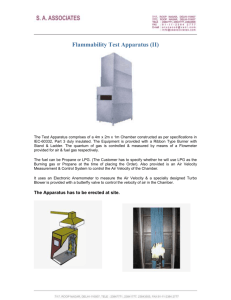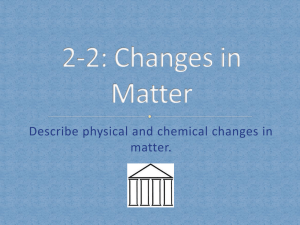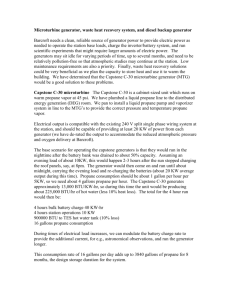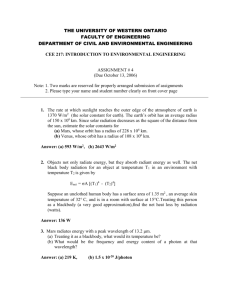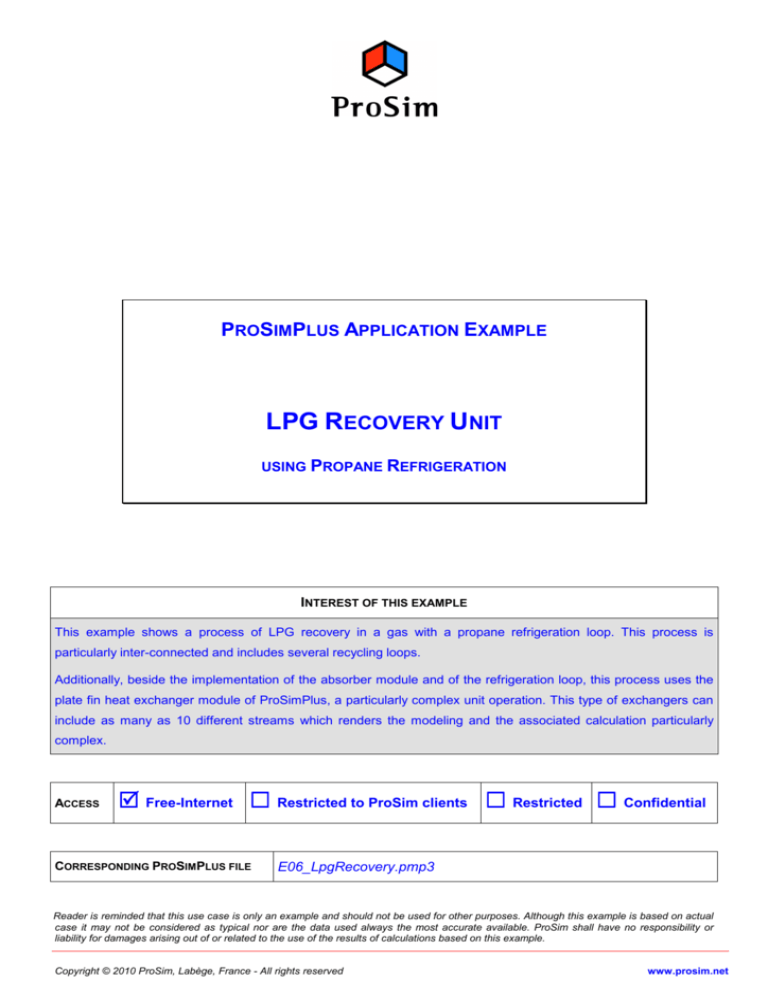
PROSIMPLUS APPLICATION EXAMPLE
LPG RECOVERY UNIT
USING PROPANE REFRIGERATION
INTEREST OF THIS EXAMPLE
This example shows a process of LPG recovery in a gas with a propane refrigeration loop. This process is
particularly inter-connected and includes several recycling loops.
Additionally, beside the implementation of the absorber module and of the refrigeration loop, this process uses the
plate fin heat exchanger module of ProSimPlus, a particularly complex unit operation. This type of exchangers can
include as many as 10 different streams which renders the modeling and the associated calculation particularly
complex.
ACCESS
Free-Internet Restricted to ProSim clients Restricted Confidential
CORRESPONDING PROSIMPLUS FILE
E06_LpgRecovery.pmp3
Reader is reminded that this use case is only an example and should not be used for other purposes. Although this example is based on actual
case it may not be considered as typical nor are the data used always the most accurate available. ProSim shall have no responsibility or
liability for damages arising out of or related to the use of the results of calculations based on this example.
Copyright © 2010 ProSim, Labège, France - All rights reserved
www.prosim.net
LPG Recovery Using Propane Refrigeration
Version: January 2010
Page: 2 / 14
TABLE OF CONTENTS
1.
2.
3.
PROCESS MODELING
3
1.1.
Process description
3
1.2.
Heat exchanger description
3
1.3.
Process flowsheet
6
1.4.
Specifications
7
1.5.
Components
7
1.6.
Thermodynamic model
7
1.7.
Operating conditions
7
1.8.
"Hints and Tips"
RESULTS
10
11
2.1.
Comments on results
11
2.2.
Mass and energy balances
11
2.3.
Profile of temperature of reference sheet in the E101 exchanger
12
2.4.
Column C101 composition profiles
12
REFERENCES
Copyright © 2010 ProSim, Labège, France - All rights reserved
14
www.prosim.net
LPG Recovery Using Propane Refrigeration
Version: January 2010
Page: 3 / 14
1. PROCESS MODELING
1.1.
Process description
The objective of this process is to recover LPG (liquefied petroleum gases) with a fixed mass fraction of methane,
from a gas mixture. The main LPG components are hydrocarbons (mainly in the C3-C4 range), propane and
butane.
The initial gas mixture is sent in a two-phase separator (S101) in order to eliminate the heaviest compounds which
are sent to the distillation column (C101). The others leave at the top of the vessel and are cooled in the brazed
plate fin heat exchanger (E101). They are then forwarded in another two-phase separator (S102) to separate heavy
and lights. The two output streams (heavy and light) are sent back in the plate-fin heat exchanger as cold streams.
Once treated, the gas is mainly composed of methane and ethane and flows out of the exchanger (stream C04out).
The gas, not entirely liquefied, is sent in a deethanizer column (C101), like the bottom stream of the first two-phase
separator. This column is set to recover at the bottom, a liquid having the specified mass fraction of methane.
The main cold streams of the plate-fin heat exchanger are the two propane streams (C05out and C06out). On the
outlet side of the plate-fin heat exchanger, they are mixed and sent in a compressor (K101) which increases their
pressure and their temperature. The heat generated is recovered in an exchanger (E102). Propane then flows in an
expansion valve (v101) in order to decrease its pressure. A liquid-gas mixture is formed and sent in a separator
(S104). Liquid propane is returned in the plate-fin heat exchanger (streams C05in and C06in). The gas propane
(stream C12) is mixed with hot streams of propane leaving the brazed plate fin heat exchanger (E101).
Propane circulates in closed loop in the system where it acts as a refrigerant.
The example is extracted from [1].
1.2.
Heat exchanger description
This process implements a plate-fin heat exchanger (E101).
Only one of these exchangers can contain more than ten
different streams. Thanks to its low cost of production and its
high performances (they are generally made of brazed
aluminum), it is increasingly used in cryogenic processes. The
model implemented in ProSimPlus is a detailed model which
takes account all the complexity of the geometry of this type of
exchangers. The single assumption made is of a common wall
temperature off stacking (known as TPC assumption).
Another ProSim software, ProSec, makes it possible to bypass
this assumption for even more accurate calculations.
Copyright © 2010 ProSim, Labège, France - All rights reserved
www.prosim.net
LPG Recovery Using Propane Refrigeration
Version: January 2010
Page: 4 / 14
The heat exchanger can be summarized in the figure below:
The exchanger is composed of three references paths, shared by the hot and cold streams. The main stream (C02)
flows throughout the heat exchanger, the secondary streams are withdrawn (C05, C06) or fed (C03, C04) on the
side of the unit.
40 layers
20 layers
10 layers
Copyright © 2010 ProSim, Labège, France - All rights reserved
www.prosim.net
LPG Recovery Using Propane Refrigeration
Version: January 2010
Page: 5 / 14
The figures below present the fins used for the several flow paths in the heat exchanger as well as their topology
(exchange, distribution and dead zones). Only one fin is used in this example (Fin #2873 from Fives Cryo (formerly
called Nordon Cryogénie)):
Copyright © 2010 ProSim, Labège, France - All rights reserved
www.prosim.net
LPG Recovery Using Propane Refrigeration
Version: January 2010
1.3.
Page: 6 / 14
Process flowsheet
LPG recovery unit process flowsheet
Copyright © 2010 ProSim, Labège, France - All rights reserved
www.prosim.net
LPG Recovery Using Propane Refrigeration
Version: January 2010
1.4.
Page: 7 / 14
Specifications
The constraint of this process is to recover LPG with a mass fraction of methane equal to 0.05. This constraint is
set in the column (C101) configuration window (“Objectives / Constraints” tab).
1.5.
Components
The components taken into account in the simulation are extracted from the standard data base provided with
ProSimPlus. These components are defined in the table hereafter:
1.6.
Nitrogen
n-Butane
Methane
Isopentane
Ethane
n-Pentane
Propane
n-Hexane
Isobutane
n-Heptane
Thermodynamic model
The thermodynamic model is based on an equation of state approach. The chosen equation of state is the Peng
Robinson (PR) [2] equation with binary interaction parameters extracted from the ProSimPlus database.
1.7.
Operating conditions
Process feed
Temperature (F)
115
Pressure (psi)
833
Total mass throughput (lb/h)
26297.8
Mass fractions
Nitrogen
0.000228
Methane
0.591275
Ethane
0.098868
Propane
0.141162
Isobutane
0.040548
n-Butane
0.044816
Isopentane
0.020351
n-Pentane
0.014024
n-Hexane
0.016791
n-Heptane
0.031937
Copyright © 2010 ProSim, Labège, France - All rights reserved
www.prosim.net
LPG Recovery Using Propane Refrigeration
Version: January 2010
Page: 8 / 14
Heat Exchanger E101
Operating parameters
Type of exchanger
Value
Plate fin heat exchanger
Number of exchanger blocks
1
Number of pathes
5
Total passage numbers
70
Design material
Aluminum
Position of the exchanger
Horizontal
Fins
Fives Cryo 2873
Porosity (%)
Heat transfer coefficient (W/m2/K)
Fouling coefficient (W/m2/K)
2.5
Constant = 1000
0
Geometry
Exchange width (in)
18
Parting sheets thickness (in)
0.1
Outside sheets thickness (in)
0.25
Side bars thickness (in)
Paths description
Value
Type of separator
Vapor-Liquid separator
Temperature (F)
113
Pressure (psi)
inlet pressure
Separator S102
Operating parameters
Value
Type of separator
Vapor-Liquid separator
Temperature (F)
-5
Pressure (psi)
see § 1.2
Separator S101
Operating parameters
1
inlet pressure
Separator S103
Operating parameters
Type of separator
Copyright © 2010 ProSim, Labège, France - All rights reserved
Value
Vapor-Liquid separator
www.prosim.net
LPG Recovery Using Propane Refrigeration
Version: January 2010
Temperature (F)
Page: 9 / 14
Temperature resulting of the adiabatic mixing of the feeds
Pressure (psi)
Pressure drop (psi)
Operating parameters
Value
Exhaust pressure (psi)
258
Isentropic efficiency
0.72
Type of exchanger
Output temperature (F)
Cooler/Heater
-7
Value
Type of valve
Expansion valve
Pressure (psi)
227
Valve V102
Operating parameters
Value
Valve V101
Operating parameters
1
Exchanger E102
Operating parameters
9
Compressor K101
Mechanical efficiency
Lowest pressure of the feeds
Value
Type of valve
Stream splitter
Splitting rate
0.5
Column C101
Operating parameters
Type of column
Value
Two-phase absorber with reboiler
Number of theoretical stages
30
Feed stage
10
Vapor flowrate at the top of column (lb/h)
Copyright © 2010 ProSim, Labège, France - All rights reserved
1200
www.prosim.net
LPG Recovery Using Propane Refrigeration
Version: January 2010
Page: 10 / 14
Additional column specification:
Specification
1:
1.8.
Purity
Type of product
Component
Value
Phase
Type
Action
Bottom liquid product
Methane
0.05
Liq.
wt.
Vapor distillate flowrate
"Hints and Tips"
The propane refrigeration loop can operate with an unspecified
circulating propane flowrate, as it is a closed loop (the flow among C07
and the flow of C13 exit are equal).
In order to set the flowrate of propane circulating in the loop it is
necessary to initialize one of the streams of the loop, here the stream
C10 was selected.
In order to modify the refrigeration efficiency it will be necessary to modify
this initialization of the flowrate of C10.
Copyright © 2010 ProSim, Labège, France - All rights reserved
www.prosim.net
LPG Recovery Using Propane Refrigeration
Version: January 2010
Page: 11 / 14
2. RESULTS
2.1.
Comments on results
The calculation sequence (order of calculation of the unit operations) is generated automatically. The streams C10
(see § 1.7) and C02out are initialized.
2.2.
Mass and energy balances
This document presents only the most relevant stream results. In ProSimPlus, mass and energy balances are
provided for every stream. Results are also available at the unit operation level (result tab in the configuration
window).
Streams
From
To
Partial flowrate
NITROGEN
METHANE
ETHANE
PROPANE
ISOBUTANE
n-BUTANE
ISOPENTANE
n-PENTANE
n-HEXANE
n-HEPTANE
Total flowrate
Mass fractions
NITROGEN
METHANE
ETHANE
PROPANE
ISOBUTANE
n-BUTANE
ISOPENTANE
n-PENTANE
n-HEXANE
n-HEPTANE
Physical state
Temperature
Pressure
Enthalpy
Vapor fraction
lb/h
°F
psi
Btu/h
C01
Process feed
S101
lb/h
5,9959
15549,2190
2600,0088
3712,2470
1066,3223
1178,5612
535,1861
368,8000
441,5660
839,8722
26297,7786
C02in
S101
E101
lb/h
5,9874
15497,6221
2570,5642
3615,8181
1014,8169
1108,5416
480,3405
326,4461
330,7326
499,1964
25450,0659
C03out
E101
Gas Output
lb/h
5,7972
14212,0476
1796,6187
1587,4002
262,4924
232,8631
53,4885
32,4969
10,3296
6,3715
18199,9057
C04out
E101
C101
lb/h
0,1902
1285,5745
773,9455
2028,4179
752,3245
875,6785
426,8520
293,9492
320,4030
492,8249
7250,1602
C07
C15
C16
M101
C101
C101
S103
C1-C2 Output LPG Output
lb/h
lb/h
lb/h
0,0000
0,1954
0,0033
0,0000
1041,8992
295,2722
39,6990
348,1002
455,2898
5828,7265
507,8560
1616,9908
134,8500
112,7673
691,0626
27,3294
111,1722
834,5259
0,0000
32,7388
448,9588
0,0000
20,6876
315,6155
0,0000
9,4490
421,7874
0,0000
7,5636
825,9371
6030,6050
2192,4294
5905,4435
0,0002
0,0002
0,0003
0,0000
0,0000
0,0001
0,0000
0,5913
0,6089
0,7809
0,1773
0,0000
0,4752
0,0500
0,0989
0,1010
0,0987
0,1067
0,0066
0,1588
0,0771
0,1412
0,1421
0,0872
0,2798
0,9665
0,2316
0,2738
0,0405
0,0399
0,0144
0,1038
0,0224
0,0514
0,1170
0,0448
0,0436
0,0128
0,1208
0,0045
0,0507
0,1413
0,0204
0,0189
0,0029
0,0589
0,0000
0,0149
0,0760
0,0140
0,0128
0,0018
0,0405
0,0000
0,0094
0,0534
0,0168
0,0130
0,0006
0,0442
0,0000
0,0043
0,0714
0,0319
0,0196
0,0004
0,0680
0,0000
0,0034
0,1399
Liq./Vap.
Vapor
Vapor
Liq./Vap.
Liq./Vap.
Vapor
Liquid
114,9994
112,9994
94,6596
93,5467
-8,5950
9 3,5466
185,9031
832,9998
832,9998
832,9998
832,9998
31,0000
832,9998
832,9998
-449992,4455 -380826,1655 -383353,0502 -816587,9766 -281235,4795 -71422,6031 -448957,5698
0,9893
1,0000
1,0000
0,3524
0,9335
1,0000
0,0000
Copyright © 2010 ProSim, Labège, France - All rights reserved
www.prosim.net
LPG Recovery Using Propane Refrigeration
Version: January 2010
2.3.
Page: 12 / 14
Profile of temperature of reference sheet in the E101 exchanger
Temperature profiles in the heat exchanger are available after the simulation from the exchanger configuration
window (profile tab). A double-click on the selected profile generate the graph.
E101 - Temperature profile of the reference sheet
Temperature (°F)
120
100
80
60
40
20
0
1
2
-20
3
4
5
6
Length (ft)
Temperature profile of the reference sheet
2.4.
Column C101 composition profiles
Composition profiles can be accessed after the simulation in each column configuration window, in the “Profiles”
tab. Double clicking on the profile will generate the corresponding graph.
It is important to note that, in ProSimPlus, first stage correspond to condenser and last stage to reboiler (numbering
from top to bottom).
Copyright © 2010 ProSim, Labège, France - All rights reserved
www.prosim.net
LPG Recovery Using Propane Refrigeration
Version: January 2010
Page: 13 / 14
C101 temperature profile
C101 - Temperature profile
Temperature (°F)
200
180
160
140
120
100
80
0
10
20
30
Stage
Temperature profile in the column
C101 liquid mass-fraction
C101 - Liquid mass-fractions
Mass-fraction
0.30
0.28
0.26
0.24
0.22
0.20
0.18
0.16
0.14
0.12
0.10
0.08
0.06
0.04
0.02
0.00
1
2
3
4
5
6
7
8
9
10
11
12
13
14
15
16
17
18
19
20
21
22
23
24
25
26
27
28
29
30
Stage
NITROGEN
n-BUTANE
METHANE
ISOPENTANE
ETHANE
n-PENTANE
PROPANE
n-HEXANE
ISOBUTANE
n-HEPTANE
Liquid mass-fractions profile in the column
Copyright © 2010 ProSim, Labège, France - All rights reserved
www.prosim.net
LPG Recovery Using Propane Refrigeration
Version: January 2010
Page: 14 / 14
3. REFERENCES
[1]
Polasek J.C., Donnelly S.T., Bullin J.A.
“Process Simulation and Optimization of Cryogenic Operations Using Multi-Stream Brazed Aluminium
Exchangers”
Proceedings of the Sixty-Eighth GPA Annual Convention
Tulsa, OK : Gas Processors Association, 1989 : 100-106
[2]
Peng Y.D., Robinson D.B.
"A new two constant equation of state"
I.E.C. Fundam., 15, 1, 59-64 (1976)
Copyright © 2010 ProSim, Labège, France - All rights reserved
www.prosim.net

